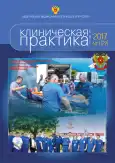КОНТИНЕНТНАЯ ИЛИ ИНКОНТИНЕНТНАЯ ГЕТЕРОТОПИЧЕСКАЯ УРОДЕРИВАЦИЯ: ЧТО ВЫБРАТЬ?
- Авторы: Перепечай В.А.1, Спицын И.М.1, Васильев О.Н.2, Коган М.И.2
-
Учреждения:
- Ростовская клиническая больница Федерального государственного бюджетного учреждения «Южный окружной медицинский Центр Федерального медико-биологического агентства»
- Ростовский государственный медицинский университет Минздрава России
- Выпуск: Том 8, № 1 (2017)
- Страницы: 50-57
- Раздел: Статьи
- URL: https://journals.rcsi.science/clinpractice/article/view/8063
- DOI: https://doi.org/10.17816/clinpract8150-57
- ID: 8063
Цитировать
Полный текст
Аннотация
Ключевые слова
Полный текст
Открыть статью на сайте журналаОб авторах
Вадим Анатольевич Перепечай
Ростовская клиническая больница Федерального государственного бюджетного учреждения «Южный окружной медицинский Центр Федерального медико-биологического агентства»
Email: perepechay_va@mail.ru
Член правления Российского Общества Урологов, Вице-президент Ассоциации урологов Дона, Руководитель Центра урологии, нефрологии, диализа и пересадки почки, Заведующий урологическим отделением РКБ ФГБУЗ ЮОМЦ ФМБА России, врач-уролог высшей квалификационной категории, д.м.н
Игорь Михайлович Спицын
Ростовская клиническая больница Федерального государственного бюджетного учреждения «Южный окружной медицинский Центр Федерального медико-биологического агентства»
Email: ispitsin@list.ru
врач урологического отделения Центра урологии, нефрологии, диализа и пересадки почки
Олег Николаевич Васильев
Ростовский государственный медицинский университет Минздрава России
Email: vasilyev_on@mail.ru
Заведующий урологическим отделением Клиники РостГМУ
Михаил Иосифович Коган
Ростовский государственный медицинский университет Минздрава России
Email: dept_kogan@mail.ru
Заместитель председателя Российского Общества Урологов, Руководитель Российской школы урологии, Президент Ассоциации урологов Дона, Зав. кафедрой урологии и репродуктивного здоровья человека с курсом детской урологии-андрологии РостГМУ, Заслуженный деятель науки РФ, д.м.н., профессор.
Список литературы
- Матвеев В.Б., Гриднева Я.В., Паяниди Ю.Г., Кислый Н.Д. Улучшение качества жизни больных после радикальных операций на органах малого таза. Медико-социальная экспертиза и реабилитация. 2011; № 4: 43-45.
- Перепечай В.А. Оптимизация хирургического лечения мышечно-инвазивного и местнораспространенного рака мочевого пузыря: Автореферат. дисс. … док. мед. наук. Ростов-на-Дону, 2016.
- Hautmann R.E., De Petriconi R.C., Volkmer B.G. Lessons learned from 1,000 neobladders: the 90-day complication rate. J Urol. 2010;184: 990-994.
- Лоран О.Б., Серегин И.В., Серегин А.В., Велиев Е.И. Функциональные результаты и качество жизни пациентов после формирования ортотопического мочевого пузыря. Анналы хирургии. 2014; № 3: 19-25.
- Коган М.И. Современная диагностика и хирургия рака мочевого пузыря / М.И. Коган, В.А. Перепечай. Ростов-н/Д, 2002. 239 с.
- Kilciler M., Bedir S., Erdemir F., et al. Comparison of ileal conduit and transureteroureterostomy with ureterocutaneostomy urinary diversion. Urol Int 2006; 77(3): 245-250.
- Kälble T. Urinary diversion with continent umbilical stoma: Which techniques are suitable for which patients? Urologe A. 2015; 54(9): 1240-1247.
- Skinner EC. Continent cutaneous diversion. Curr Opin Urol. 2015; 25(6): 555-561.
- Al Hussein A. Awamlh B., Wang L.C., Nguyen D.P., et al. Is continent cutaneous urinary diversion a suitable alternative to orthotopic bladder substitute and ileal conduit after cystectomy? BJU Int. 2015; 116(5): 805-814.
- Перепечай В.А. Результаты модифицированной техники гетеротопической илеоцистопластики по Kock после цистэктомии. Известия высших учебных заведений. Северо-Кавказский регион. Естественные науки. 2007; S1: 181-182.
- Le Duc A., Camey M., Teillac P. An original antireflux ureteroileal implantation technique: long-term follow up. J Urol 1987; 137: 1156-1158.
- Charlson M., Szatrowski T.P., Peterson J., et al. Validation of a combined comorbidity index. J Clin Epidemiol. 1994; 47(11): 1245-1251.
- Clavien P.A., Barkun J., de Oliveira M.L. et al. The Clavien-Dindo classification of surgical complications: five-year experience. Ann Surg. 2009; Vol. 250, N 2. P. 187 - 196.
- Сафиуллин К.Н., Карякин О.Б. Радикальная цистэктомия в лечении немышечно-инвазивного рака мочевого пузыря. Онкоурология. 2012; № 2: 40-44.
- Даренков С.П., Самсонов Ю.В., Чернышов И.В. и др. Качество жизни больных инвазивным раком мочевого пузыря после радикальной цистэктомии. Онкоурология. 2006; 3: 25-29.
Дополнительные файлы






